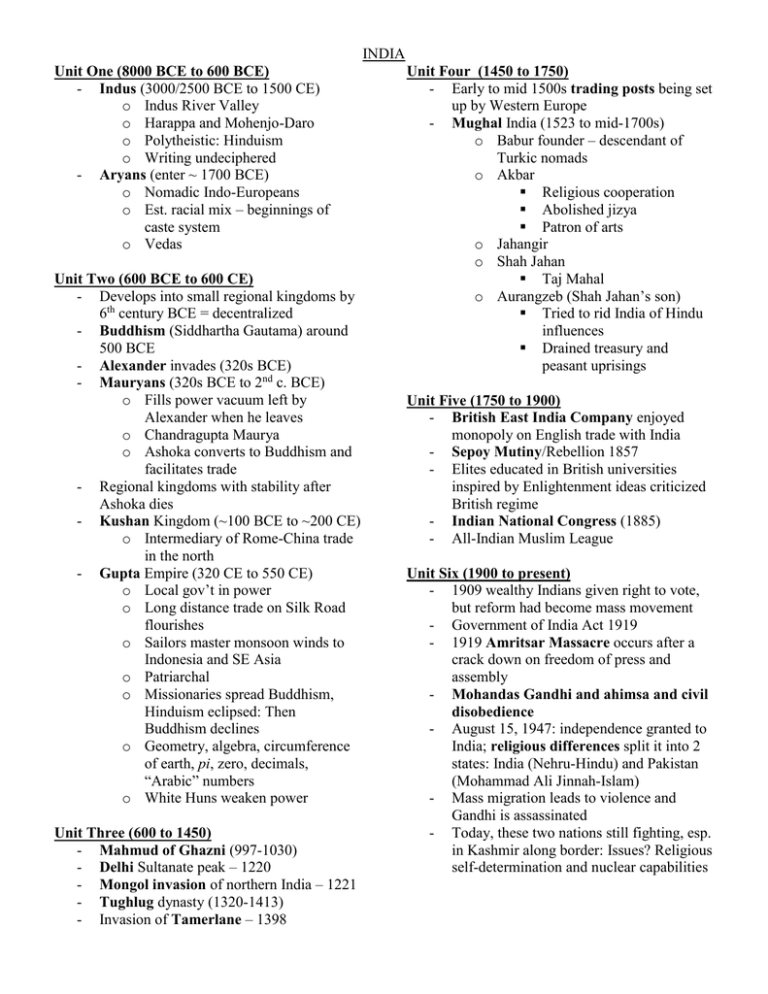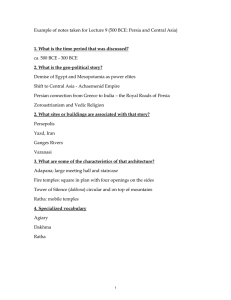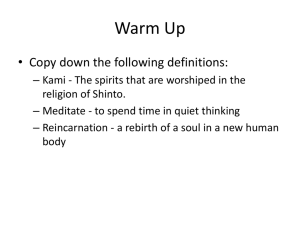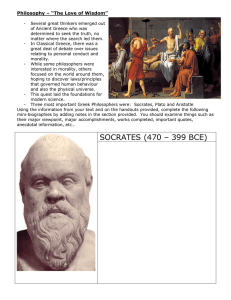India
advertisement

INDIA Unit One (8000 BCE to 600 BCE) - Indus (3000/2500 BCE to 1500 CE) o Indus River Valley o Harappa and Mohenjo-Daro o Polytheistic: Hinduism o Writing undeciphered - Aryans (enter ~ 1700 BCE) o Nomadic Indo-Europeans o Est. racial mix – beginnings of caste system o Vedas Unit Two (600 BCE to 600 CE) - Develops into small regional kingdoms by 6th century BCE = decentralized - Buddhism (Siddhartha Gautama) around 500 BCE - Alexander invades (320s BCE) - Mauryans (320s BCE to 2nd c. BCE) o Fills power vacuum left by Alexander when he leaves o Chandragupta Maurya o Ashoka converts to Buddhism and facilitates trade - Regional kingdoms with stability after Ashoka dies - Kushan Kingdom (~100 BCE to ~200 CE) o Intermediary of Rome-China trade in the north - Gupta Empire (320 CE to 550 CE) o Local gov’t in power o Long distance trade on Silk Road flourishes o Sailors master monsoon winds to Indonesia and SE Asia o Patriarchal o Missionaries spread Buddhism, Hinduism eclipsed: Then Buddhism declines o Geometry, algebra, circumference of earth, pi, zero, decimals, “Arabic” numbers o White Huns weaken power Unit Three (600 to 1450) - Mahmud of Ghazni (997-1030) - Delhi Sultanate peak – 1220 - Mongol invasion of northern India – 1221 - Tughlug dynasty (1320-1413) - Invasion of Tamerlane – 1398 Unit Four (1450 to 1750) - Early to mid 1500s trading posts being set up by Western Europe - Mughal India (1523 to mid-1700s) o Babur founder – descendant of Turkic nomads o Akbar Religious cooperation Abolished jizya Patron of arts o Jahangir o Shah Jahan Taj Mahal o Aurangzeb (Shah Jahan’s son) Tried to rid India of Hindu influences Drained treasury and peasant uprisings Unit Five (1750 to 1900) - British East India Company enjoyed monopoly on English trade with India - Sepoy Mutiny/Rebellion 1857 - Elites educated in British universities inspired by Enlightenment ideas criticized British regime - Indian National Congress (1885) - All-Indian Muslim League Unit Six (1900 to present) - 1909 wealthy Indians given right to vote, but reform had become mass movement - Government of India Act 1919 - 1919 Amritsar Massacre occurs after a crack down on freedom of press and assembly - Mohandas Gandhi and ahimsa and civil disobedience - August 15, 1947: independence granted to India; religious differences split it into 2 states: India (Nehru-Hindu) and Pakistan (Mohammad Ali Jinnah-Islam) - Mass migration leads to violence and Gandhi is assassinated - Today, these two nations still fighting, esp. in Kashmir along border: Issues? Religious self-determination and nuclear capabilities






